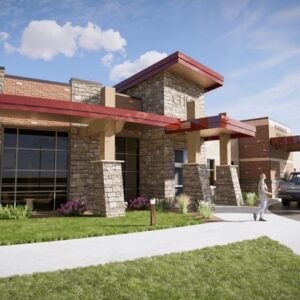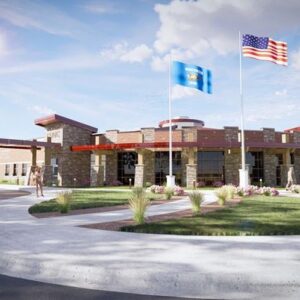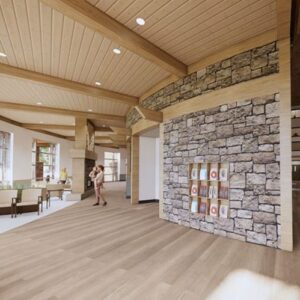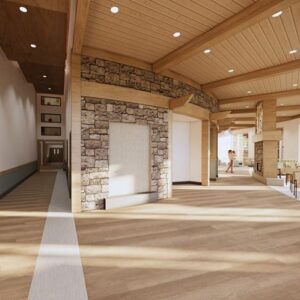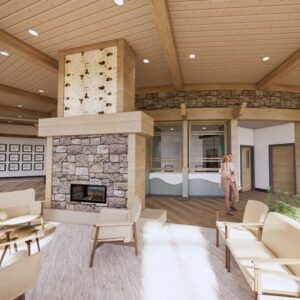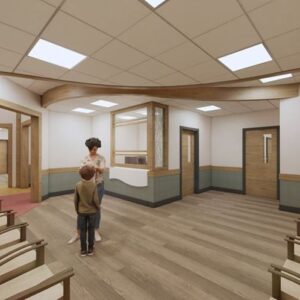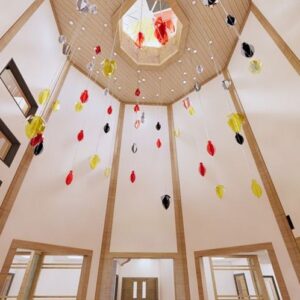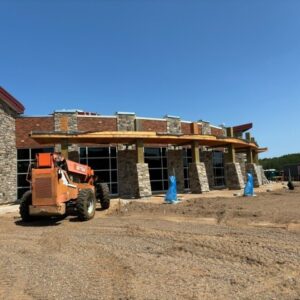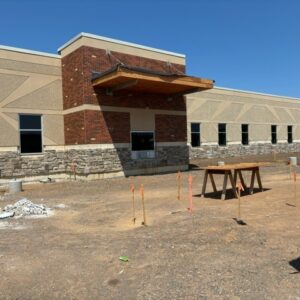In a Nutshell
What: Leveraging New Markets Tax Credits (NMTCs), the Lac Courte Oreilles Band of Lake Superior Chippewa Indians is developing a new, state-of-the-art tribal health center that will consolidate two aging facilities into one new location. Doing so will nearly double the clinic’s capacity and enable the expansion of existing services and the launch of new health and wellness programming designed to more comprehensively meet the health care needs of tribal members and other residents in the rural area.
Sector: Health Care
Location: Sawyer County, WI
Size: 64,421 square feet
Cost: $48.7 million
Funding and Financing Sources: $44.3 million NMTC allocation from US Bank and Equitable Health Fund (LISC), consisting of Qualified Equity Investments (QEIs) from Forward Community Investments, Impact Seven, IFF, LISC, and US Bank; loans from Native American Bank and Bay Bank, including participation from IFF, Wisconsin Native Loan Fund, First American Capital Corp., Oweesta Corporation; American Rescue Plan Act funds; tribe equity
IFF Support: $11.425 million NMTC allocation and a $2 million loan closed in November 2023
IFF Staff Leads: Marina Titova, managing director, Structured Finance; Alex Mendoza, director, Structured Finance; Farah Ansari, underwriter, Structured Finance
Design: Brunton Architects & Engineers
General Contractor: Woodstone
New Markets Tax Credit Consultant: Baker Tilly Capital (Matthew Pugh)
Project Manager: Glenn Hall
Impact: 121 full-time jobs retained/created; 42 temporary construction jobs created; 14,200+ patients making more than 77,400 annual visits
Near the intersection of County Highways B and K in Sawyer County, WI, a gleaming new facility is rapidly taking shape, representing a $48.7 million investment in the future that will drastically improve access to quality health care in the rural community (population: 18,074). Being developed by the Lac Courte Oreilles Band of Lake Superior Chippewa Indians (LCO), the new, 64,421-square-foot tribal health center will replace two aging facilities elsewhere on the LCO Reservation and enable comprehensive, culturally appropriate health and wellness services to be provided in one state-of-the-art location.
Having long struggled to keep pace with the demand for health services in outdated, cramped facilities no longer equipped to fully support the health center’s mission, the positive impact of the new facility will be both immediate and multifaceted. With the ability to accommodate more than 77,400 annual patient visits, LCO’s nearly 7,300 tribal members will no longer have to wait months on end – or longer – for health services, nor will they have to travel long distances to access care and treatment.
“This project is a godsend,” says Dr. Gary Girard, the former director of the LCO Community Health Center, who helped develop the plans for the new facility. “The new building is enormous and, with 33 percent more capacity than the health center had previously, it’ll be possible to double the number of patients served annually within six months of its opening.”
In addition to making high-quality health care more accessible to more people, the new facility will enhance the LCO Health Center’s ability to provide routine, day-to-day medical care, as well as more specialized services for older adults, those with diabetes, and individuals working to overcome substance use disorder – all of which have been identified by the health center as particularly acute local needs. This is consistent with the health care needs of the broader Native population of the United States, resulting from centuries of structural discrimination, forced relocation, limited economic opportunities, and chronic underfunding of health care that has created persistent disparities in health outcomes.
To more holistically serve LCO tribal members, the new health center will house medical and dental clinics, a pharmacy, behavioral health services, substance use disorder recovery resources, a chiropractor, an optometrist, a podiatrist, a lab, and a dedicated space for medical imaging. New and expanded services will include preventative health services, including annual physicals and screening for chronic diseases for early detection and treatment; youth-based health services; prenatal care and parenting classes; urgent care, and a drive-through for the pharmacy, among other examples. Amplifying the positive impact of the new facility will be the purchase of new equipment for mammograms, ultrasounds, and x-rays – all of which will expand the health center’s ability to provide high-quality, client-centered care.
Beyond expanding the health center’s capacity, LCO’s new facility will streamline the health center’s operations to improve the patient experience and increase connectivity between the services offered on-site. Designed by Brunton Architects & Engineers with input from health care staff, patients, contractors, elders, a health care advisory board, and the tribal governing board, the new facility will include 360-degree parking around the circular structure and multiple entrances, each with patient registration stations, to ensure that patients can easily access the area of the facility where their appointment is located.
Similar thoughtfulness was applied to the interior design, with core medical services located in the center of the building and ancillary services in a ring around the outer edge of the facility. Using the space in this way – along with the centralization of all tribal health services in one location – will make it far easier for clinic staff to help patients access the full range of services offered by the health center.
“With more exam rooms and expanded administrative space, the objective in the new center will be for patients to see a provider more quickly after checking in, and without having to go through the entire building to get to the appointment,” says Girard. “And when a dentist recognizes that a patient has high-blood pressure, for example, the dentist will be able to easily direct the patient to the provider in the building that’s best equipped to help with that. Being able to do a warm handoff in the building is going to help the clinic take care of the full range of patients’ medical needs.”
On track to open in February 2025, the new LCO Health Center will focus first on reducing the backlog of appointments for tribal members that have accumulated in recent years. Once accomplished, the clinic will open its doors to non-tribal members of the community, benefiting area residents with limited options for high-quality health care. Doing so will also benefit the health center itself, which anticipates hiring approximately 15 new full-time staff members as a result of the increased third-party revenue generated by opening the clinic to patients who are not members of the LCO tribe. In total, the project will retain and create 121 permanent full-time jobs, and create 42 temporary, full-time equivalent construction jobs.
Partnerships clear the way for new LCO Health Center
The LCO Health Center project is the first Native project for which IFF has allocated New Markets Tax Credits (NMTCs), as well as the first NMTC project IFF’s Structured Finance team has supported in a rural community. As a result, the partnership between IFF and the other lenders involved in the financing for the new LCO Health Center was essential, bringing together a team with complementary experience and expertise.
To support the deal, IFF provided informal technical assistance about the deployment of NMTCs, while the Native American-focused lenders helped navigate the complexities of closing a deal of this size on tribal land, where facilities developed using NMTCs cannot be used as collateral because of the unique legal status of tribal lands.
In recognition of the innovative nature of LCO’s project and the partnerships that facilitated the financing needed, the project has received national recognition. Earlier in 2024, Novogradac recognized the project as its 2024 Nonmetropolitan QLICI of the Year, while the Native American Finance Officers Association honored the project as its deal of the year.
With additional revenue generated by the health center’s expansion, LCO anticipates being able to pay off the new facility within seven years of its opening, which is also the result of a financing structure that’s utilizing a $44.3 million New Markets Tax Credit (NMTC) allocation to reduce the financial burden on the tribe to develop the transformational facility. IFF provided $11.425 million as part of the total NMTC allocation, in addition to a $2 million loan, partnering with five other lenders to bring LCO’s new health center to fruition.
This includes US Bank and Equitable Health Fund (LISC), which provided the full NMTC allocation, consisting of Qualified Equity Investments (QEIs) from IFF, Forward Community Investments, Impact Seven, LISC, and US Bank. Sources of leverage funding include loans from Native American Bank and Bay Bank, with participation from IFF, Wisconsin Native Loan Fund, First American Capital Corp., and Oweesta Corporation, and additional contributions coming from tribe equity and American Rescue Plan Act (ARPA) funds, among other sources.
“Access to capital for projects like this is generally a challenge for tribes, and there’s not always a long list of lenders that can navigate NMTC deals and are comfortable with lending to tribal entities,” says Joel Smith, president of Native American Bank’s Community Development Division. “That often means that tribal projects like the LCO Health Center have to wait until enough grant funding has been secured to move forward, despite the need that exists for high-quality health care. This was a project that would have been difficult for any single lender to take on, and so the partnerships to get the deal closed were essential.”
At the end of the seven-year compliance period required for NMTCs, approximately $9 million of the NMTC equity investment will convert to equity for LCO, helping to bolster tribal finances, facilitating the addition of new services at the health center like a dialysis center, and reducing barriers to the development of a more comprehensive wellness campus that the new health center will anchor. Current plans call for a wellness center adjacent to the new health clinic with a track and fitness equipment, as well as a dedicated facility for senior services that will deepen the impact of the health center.
“We picked the location for the new health center because it’s at one of the busiest intersections in the county, making it accessible to patients, and because of the room there to grow both the health clinic and the broader wellness campus,” concludes Girard. “Our patients deserve the best care, and we’re going to have the space needed to continue offering that well into the future so that future generations can get the health care they need to thrive.”
Learn about additional projects in Wisconsin supported by IFF’s Capital Solutions team
